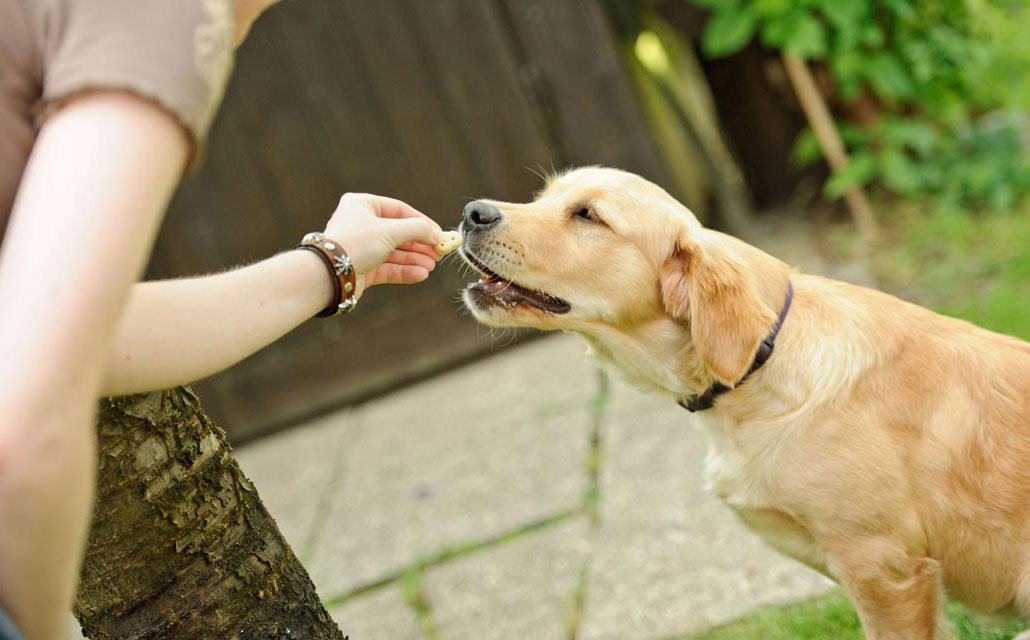Keep These Things in Mind When Baking Homemade Dog Treats

Making homemade treats for your dog can be a great idea. After all, many pre-packaged canine treats contain lots of unhealthy ingredients like extra sugar, salt, artificial flavors, and dyes. Still, baking dog treats at home means you'll need to know a few things about food safety, both in general and specifically as it relates to your pup.
Don't Use Dog-Toxic Ingredients
Dogs can't safely eat everything that humans can. Some seemingly innocuous ingredients may cause harm or even death to a canine that consumes them.
For example, grapes and raisins, garlic and onions, and chocolate are toxic to dogs. Additionally, xylitol, a natural sweetener used in many human foods to reduce the sugar content, is extremely dangerous to dogs. It causes a life-threatening drop in blood sugar, and at higher doses, it can result in liver failure.
Peanut butter, which is a common ingredient in homemade dog treats, is increasingly made with xylitol instead of sugar, so you must read nutritional labels carefully if you're going to cook for your dog.
You can learn more about what to avoid using here: "Foods Toxic to Dogs." If you're ever unsure about an ingredient, err on the safe side and don't use it.
Check out this fun dog treat recipe: "Crispy Pumpkin Dog Treat Recipe."
Don't Add Extra Fat
Dogs' systems can't break down and use fat the same way humans' do. In fact, too much fat can result in painful, life-threatening pancreatitis. Don't add more fat than you absolutely have to when making dog treats.
Sugar Isn't Necessary
Dogs don't need treats that have sugar in them. You can skip the frosting and stick to the savory side of the palate. Sugar just adds unnecessary calories.
You can make treats out of some types of canned food. If your dog is on a prescription diet, this might be a good way to make treats. Check it out: "How to Make Canned Food into Treats for Your Dog."
Use Good Food Safety Techniques
If you're baking treats that contain eggs or meat, be sure to follow proper food handling techniques and cook the treats thoroughly. Dogs can suffer from salmonella if they eat raw or undercooked meat or eggs.
Avoid Using Unsafe Baking Containers
Look for BPA-free baking containers if you use them to make treats. But be sure not to leave them where your dog can get to them because if they eat the treat container and all, they could require surgery. Learn more: "A New Bowel Obstruction Risk You Need to Know About."
Watch the Calories
Remember that the treats you make your dog have calories in them. Keep them small and limit the number you give your dog daily. Treats shouldn't make up more than 10% of your dog's diet. If you're giving too many treats, your dog could become overweight. Alternatively you, he might not eat his regular diet as well if he's too full from treats, and that can lead to nutritional imbalances and health problems.
This article discusses dog treats only. If you're interested in homemade diets for dogs, check out this article: "Dangers of Homemade Diets for Dogs."
You May Also Like These Articles:
Dog Training Tips: Using Treats Properly
How to Make Canned Food into Treats for Your Dog
Why You Should Avoid Bone Treats for Your Dog
First Aid for Electrocution Injuries in Dogs
How to Make Your Car a Safe Place for Your Dog
General Tips for Keeping Your Dog Safe
Disclaimer: This website is not intended to replace professional consultation, diagnosis, or treatment by a licensed veterinarian. If you require any veterinary related advice, contact your veterinarian promptly. Information at DogHealth.com is exclusively of a general reference nature. Do not disregard veterinary advice or delay treatment as a result of accessing information at this site. Just Answer is an external service not affiliated with DogHealth.com.
Notice: Ask-a-Vet is an affiliated service for those who wish to speak with a veterinary professional about their pet's specific condition. Initially, a bot will ask questions to determine the general nature of your concern. Then, you will be transferred to a human. There is a charge for the service if you choose to connect to a veterinarian. Ask-a-Vet is not manned by the staff or owners of DogHealth.com, and the advice given should not delay or replace a visit to your veterinarian.



